Read all about arctic foxes in Iceland and how to see them!
This post contains affiliate links for which Expedition Wildlife may receive a commission (where applicable) at no additional cost to you.
Iceland is a country filled with magical landscapes and special wildlife that lay hidden in rocky shores and volcanic outcroppings.
The country is massive, and although tourism has risen dramatically in Iceland over the past decade, there are still spots you can visit where the visible footprint is all but nonexistent.
One such place is Hornstrandir Nature Reserve, an isolated peninsula in the northwestern corner of Iceland. Roads do not penetrate the Reserve and as such, reaching the Reserve can be difficult.
This also means you’re unlikely to find many people during your visit.
We’ve found that Hornstrandir is the best place to spot Arctic Foxes (Vulpes lagopus) in Iceland. Keep reading to find out why!
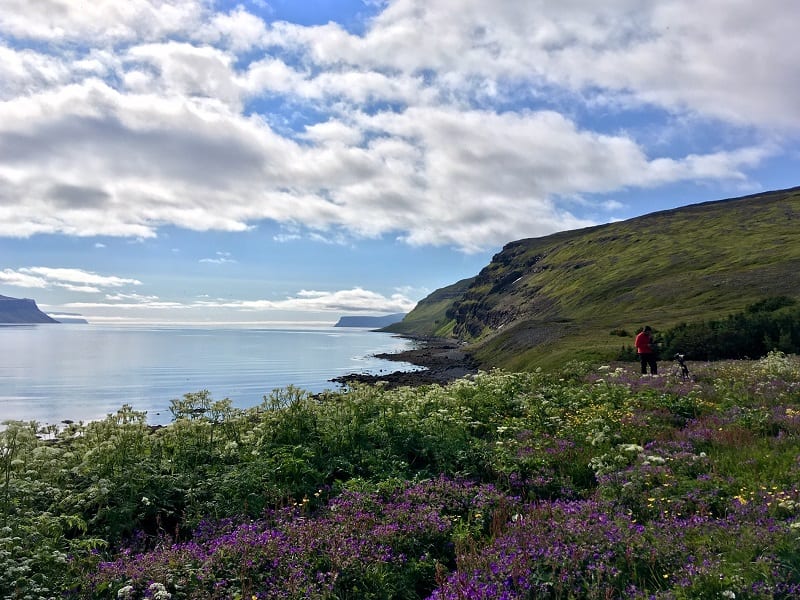
Just look at the fjord view! The wildflowers in Icelandic summertime are beautiful in the Nature Reserve. Photo by Christa Rolls
About Hornstrandir Nature Reserve
The Hornstrandir Nature Reserve was established in the 1970s as an area of exceptional beauty and diversity.
Over 220 acres in size, this massive natural gem is characterized by fjords, black-sand beaches, and cliffs.
Active homesteads are still used along its rocky coasts, accessible only by boat or on foot. The remnants of old farms and the homes of fishermen can still be seen scattered throughout the land.
You’ll be hard-pressed even to find a sheep this far north. It is said that a few wandered up the peninsula on accident and spent out the rest of their days eating tasty wildflowers.
There are no large-scale, established trails in the Reserve, other than those way-marked by massive cairns. These were once used by those living on the peninsula to navigate from place to place.
There is also no grazing, meaning the Reserve has exceptional amounts of native woody and flowering plants.
The creatures that depend on the diversity of plant life thrive, too. The fewer the people, the more wildlife can thrive without disturbance, making this spot the best for seeing Arctic Foxes in their natural habitat.
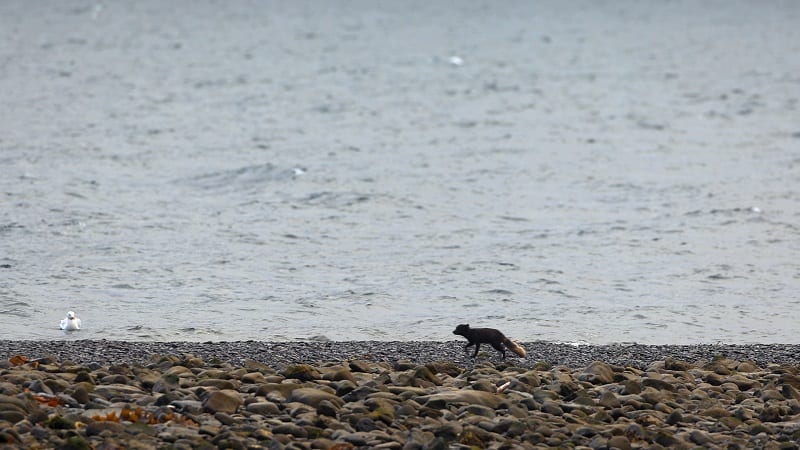
Arctic Foxes can be seen fairly easily in Hornstrandir… if you know where and how to look! Photo by Nathan Rolls
Why is Hornstrandir one of the best places to see Arctic Foxes?
Because it has been relatively undisturbed, Hornstrandir Nature Reserve is the best place to spot arctic foxes in Iceland.
Not only this, but the winds blow ample amounts of food to the shores for foxes to eat.
It is possible to see foxes in other parts of the country, but it is considered quite rare. People have also spotted the foxes along the shores outside Ísafjörður.
Arctic foxes forage, primarily, on the shores of the fjords, so the best place to spot the foxes is along the water’s edge.
They roam back and forth across the shore, so situating yourself on the shoreline with some camouflage will be the best way to spot the foxes. We recommend a camouflaged tarp to protect you from the elements, too.
You can see Arctic Foxes from Kviar Lodge and the scopes and binoculars available to you there. It’s even possible from a kayak as you peruse the shores quietly. Without a doubt, sitting on the shore quietly away from others increases the chances that you’ll see them.
Remember, wildlife sightings are never guaranteed, but blending in and being quiet certainly makes it more likely!
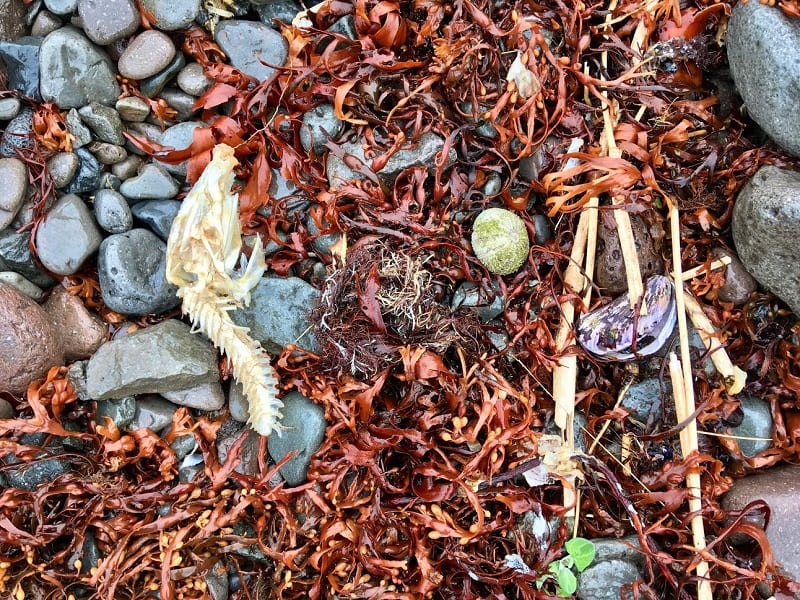
Some of the things that wash up on shore in Iceland – some good options for foxes. Photo by Christa Rolls
About Arctic Foxes in Iceland
First, why is it important to learn about Arctic Foxes when learning where to find them?
Becoming a naturalist is an important component of wildlife watching. It helps us to ethically and effectively see the animals we seek. You can read more about that in our wildlife photography tips and guide here.
Morphology of Arctic Fox fur
The Arctic Fox is the only native mammal in Iceland, present on the landmass for thousands of years.
More incredibly is how much the Arctic Fox has adapted to its environment. It changes fur color based on the season and the surrounding environmental changes!
There are different morph colors, including blue and brown. The blue morphs, almost a slate gray, are much rarer than the brown variety.
While you might think Arctic Foxes always turn white in winter, that isn’t always the case.
In Iceland, only about 30% of foxes turn white, an adaptation made over generations in response to the foraging grounds on which they are typically seen.
True, snow falls heavily in some parts of Iceland during the wintertime. However, the coastlines still remain a mess of greys and browns, perfect for foxes to blend in during their foraging and hunts.
Those that do turn white during the wintertime can be seen sporting white patches as they shed the thick layer of fur into spring and summer. It is likely if you spot a pair together, the one with the least amount of white on it is likely the female. Female foxes tend to spend more time going in and out of their burrow tending to their young, subsequently rubbing off the white outer-fur.
Arctic foxes in Iceland do not hibernate, rather they sleep for long hours during the day and morph into a color that allows them to better blend in with their environment for hunting at that time of year.
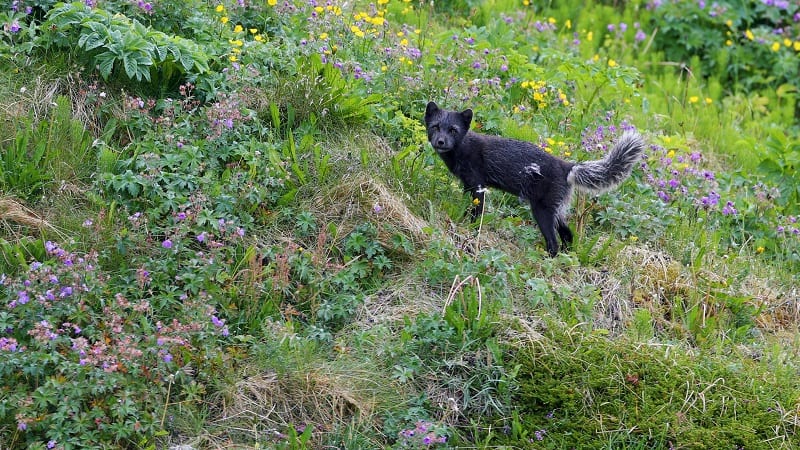
Note the remaining white fur on the tail, slowly shedding after Iceland’s winter season. Photo by Nathan Rolls
General Arctic Fox Ecology
Arctic Fox Size
Foxes weigh only around 10 pounds (4.5 kg), so size-wise, they aren’t very large.
Their larger winter coat makes them look much larger than they actually are. Their tails are almost as large as their body and are used as a makeshift blanket that they can wrap themselves up in for warmth.
When you see the agility of a fox, sporting over rocky beaches as if it weren’t a chore, you’ll note their tail also allows them to balance incredibly well.
Arctic Fox Diet
In Iceland, the foxes primarily eat birds, bird eggs, fish, and carrion.
On the rocky shores and coastlines, shore-loving waterfowl must remain vigilant for potential predators nearby.
Arctic Fox Territories
Arctic Fox territories can be massive, up to nearly 4 square miles. Given this, patience is key when searching out these beautiful animals.
Since they love to sleep and can have a massive area in which they hunt for food, it can take time for one to loop around to where you might be waiting.
Cultural Significance
The Arctic Fox’s presence is of significance to Icelandic history and Icelandic people. The Arctic Fox is especially a symbol of the environment, rugged and adaptable, as well as that of life when their warm fur once sustained people from frigid Icelandic winters.
Today they are protected, however, now their primary strife is finding natural food sources. Because of shifting temperatures in the North Atlantic, the multitude of sea life they once depended on has also shifted.
Best time to see Arctic Foxes in Iceland
Technically, you can visit Hornstrandir any time of year but keep in mind that the weather will be your big limiting factor.
The boats from Isafjordur to Hornstrandir only run in the summertime and may not run if the weather turns inclement (read more about this below).
Without the proper equipment in wintertime, you’re bound to get frostbite.
Boats may not venture into the waters often in winter. However, helicopters are another way of getting around during this limiting time of the year.
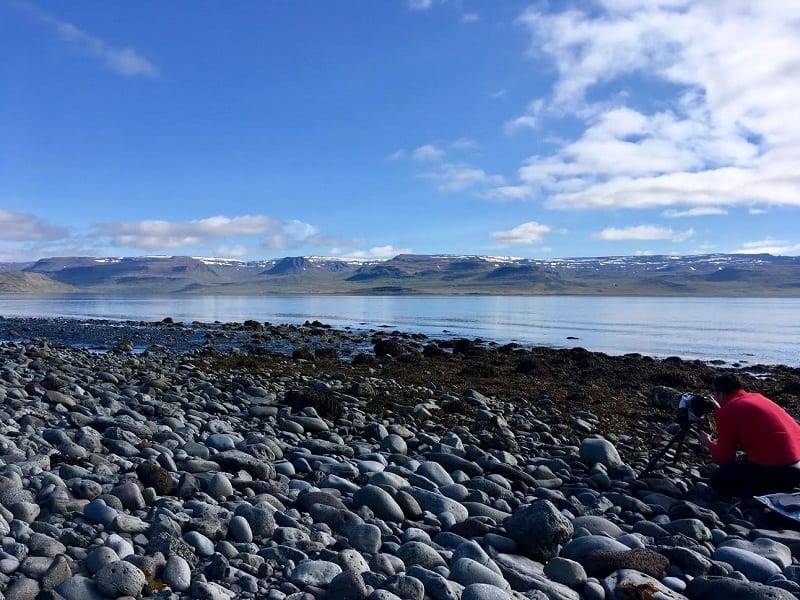
Hornstrandir has beautiful pebble stone shorelines, on which Arctic Foxes must skip to navigate and find food. Photo by Christa Rolls
Cost of seeing arctic foxes in Iceland
The cost of visiting Hornstrandir and searching for foxes, even for a day, is extensive.
Standard boats to Hornstrandir (see below) run around 13,000 ISK (~$90) per person one way.
Tours for one night (2 days) are around $600 per person total (including accommodation, transportation, and food). This is a modified version of the tour we took – we only stayed for one night, not three. We also stayed in a Lodge instead of camping out.
While staying for a shorter period of time does limit the possibility of seeing foxes, it is possible to stretch out your search time in summer.
During our July trip, we spotted two foxes on the shoreline fairly consistently. However, we were sitting in the freezing cold under a tarp blind for a while to get the opportunity.
Getting to Hornstrandir Nature Reserve
Getting to Isafjordur
The first task in getting to Hornstrandir is getting to Hornstrandir’s jumping-off point, the town of Isafjordur.
Hornstrandir is an isolated peninsula on the northwestern part of Iceland. No roads go into the Nature Reserve, thus much of the area is quite wild.
The only way to get to Hornstrandir is by boat from Isafjordur, or to hike in from the mainland. The latter, however, can take an enormous amount of time given the very hilly and rocky terrain.
We stayed the previous night before our tour at the Tunguskogur Campground in our campervan. This is a really lovely campsite with nice amenities and a beautiful nearby waterfall hike!
There are plenty of other places to stay in Isafjordur here:
Drive from Reykjavik
From Reykjavik, Isafjordur is around a six-hour drive. The roads in the Westfjords, as the region is called, are quite remote, winding, and not always paved.
If you decide to make the trek up to Isafjordur by car, consider renting a 4×4 vehicle and definitely get vehicle insurance, to include gravel damage.
This is the route we took since we wanted to stop along the way and see the area!
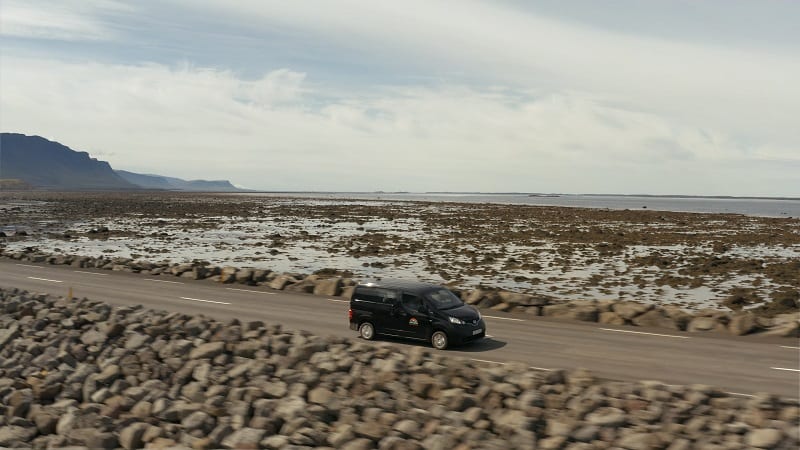
Read more about exploring Iceland by campervan here! Photo by Nathan Rolls
Fly from Reykjavik
If you don’t have the time to spend driving to the Westfjords, you can fly from Reykjavik to Isafjordur.
Logistically, you’ll need to get to Reykjavik inner-city airport, then take transportation from the airport into Isafjordur.
Thankfully, the tours you take into Hornstrandir will have arrangements to meet with you in Isafjordur!
Getting to Hornstrandir
You can either take a tour into Hornstrandir or take the boat on your own into the Reserve.
Take a Boat on your own to Hornstrandir
There are two companies that you can go with to get to Hornstrandir: Sjóferðir and Borea.
If you’re planning ahead and looking to camp in Hornstrandir or hike in the area for a couple of days, you can go with either of these boating agencies.
We definitely recommend going with a tour guide for safety reasons as well as to enhance your chances of seeing foxes.
Note: If you hike in the Reserve, there are large cairns at the top of nearly every hill to guide the way between fjords and villages. This is how many people got around decades and centuries ago before the villages and homesteads became all but nonexistent. DO NOT disturb the rock cairns.
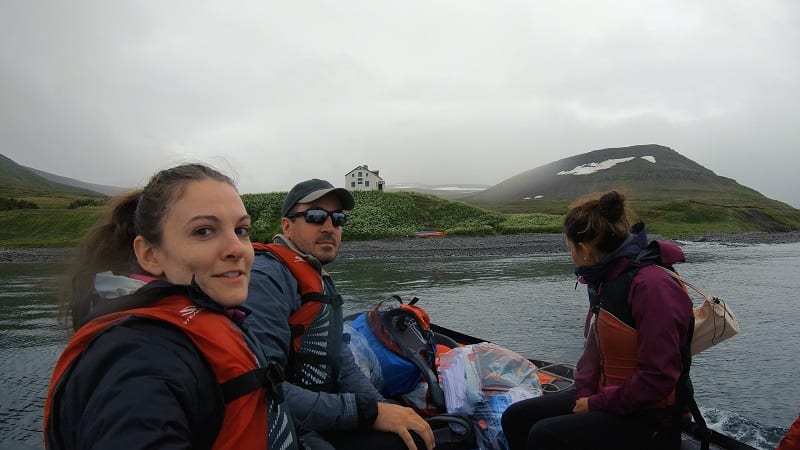
The Kodiak boat travels from the main ferry boat to the shores outside Kviar Lodge. Photo by Christa Rolls
Take a tour into Hornstrandir (via boat)
Borea Adventures is the company recommended by the Arctic Fox Centre (see further down for more info) for visiting Hornstrandir and spotting foxes. So, we quickly coordinated a trip with them.
Borea’s small boat shuttles people from Isafjordur to the Reserve near-daily, weather-depending.
There are multiple potential stops along the peninsula. Some people will stop off at certain sites to camp out, others will continue on to Kviar Lodge to spend the night, as we did, and fewer still will trek all the way around to the other side of the peninsula to Horn.
The minimum amount of time on the boat is around one hour, so if you are prone to seasickness, this is the time to take your Dramamine. It’s surprising how rough the waters are, as you pass through the straight that goes between Isafjordur and Hornstrandir.
What to expect with Borea Adventures
Our time spent with our guide at Borea Adventures was one of the highlights of our trip. We did a modified version of this tour, only visiting for one night.
From the time we started planning our trip to see foxes via email, to actually going on the trip, we never felt like we were missing something.
I coordinated with Borea a week before we left on our trip just to make 100% sure we were set to go on our trip.
This is something I recommend doing before any major trip or tour! Follow up on any last-minute details, such as logistics or gear you’ll need to bring.
The knowledge of Borea’s guides is phenomenal. Any questions you have about the history of the region, the flora or fauna, and life in Iceland, they will have the answers for you.
Arctic Fox viewing trips, trekking, camping, and bird watching trips of all kinds are available through Borea Adventures. The timeframe spent can be anywhere from a half or full day, to overnight, to multiple nights. They are really flexible!
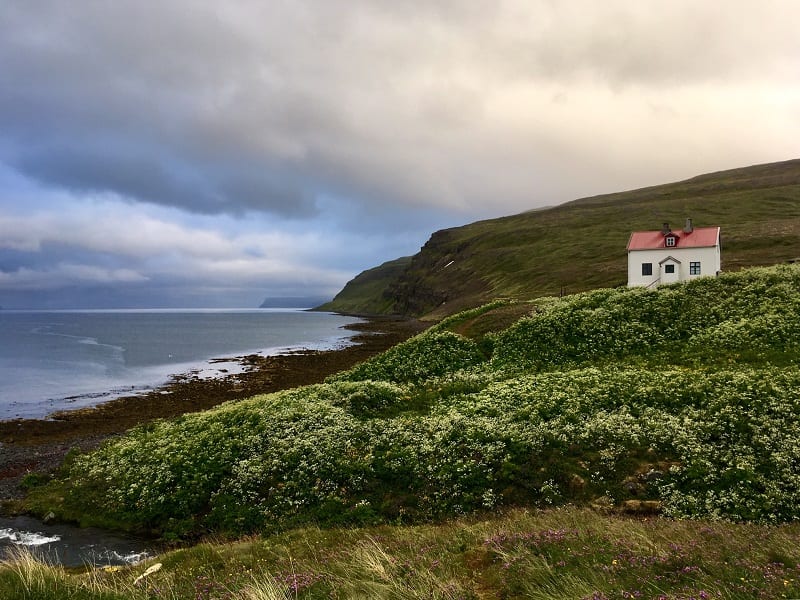
Kviar Lodge is a remote outpost on Hornstrandir, and the ideal spot to see Arctic Foxes in Iceland! Photo by Christa Rolls
Fox Watching Etiquette
Absolutely DO NOT attempt to feed the foxes.
It’s possible you’ll come across visiting photographers or others who have small fish they leave out for the foxes to lure them closer. Don’t give in to doing the same.
These are still wild animals. Baiting can alter an animal’s behavior, including making them less wary of people. Not everyone appreciates wild animals walking up to them – this is where the saying “a fed animal is a dead animal” comes from. Let the wildlife forage on what they naturally eat.
In addition, if you find a fox den, keep your distance from it and let the parents tend to their young.
Maintain the good practice of not feeding wildlife and maintaining your distance wherever you go!
Read more about how to respect wildlife during your time in nature here.
Gear Necessities
No matter where you are visiting in Hornstrandir, you’ll need to be prepared with the right gear.
The weather is not very forgiving, even in the “heat” of summer. Given this, being prepared is essential!
- Rain jacket and rain pants (her); Rain jacket and rain pants (him)
- Layers with warm socks for her, warm socks for him, gloves, and hat
- Waterproofs for any equipment you bring out – we recommend LensCoat
- Rainfly or another portable water-resistant tarp
- Waterproof Go-Pro
Note for hikers and campers: be sure to coordinate meeting locations, trail etiquette, and gear requirements with local guides before venturing into the Hornstrandir wilderness.
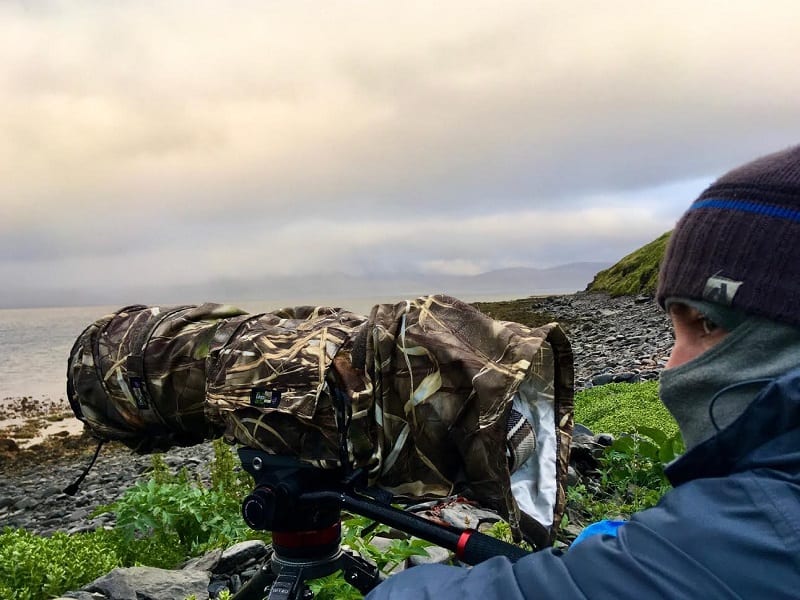
Even in July the weather can be cold, windy, and rainy! Photo by Christa Rolls
The Arctic Fox Centre
The Arctic Fox Centre in Súðavík offers loads of information about these elusive creatures.
This non-profit organization is a research center and natural history museum. The Centre brings Iceland’s visitors closer to learning more about these beautiful creatures through eco-tourism practices and conducting scientific fieldwork.
Their goal is to learn more about the Arctic Fox populations in Iceland to better understand them and how to protect them. Learn more about Arctic Foxes and their populations on their website!
Have you seen Arctic Foxes before? Tell us about your experience in the comments!
Happy Travels,
Christa and Nathan
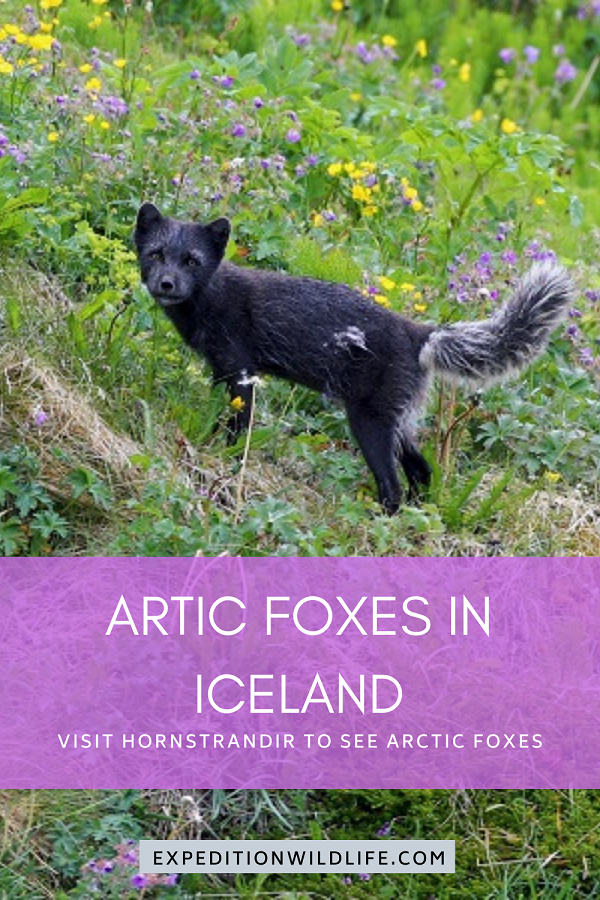

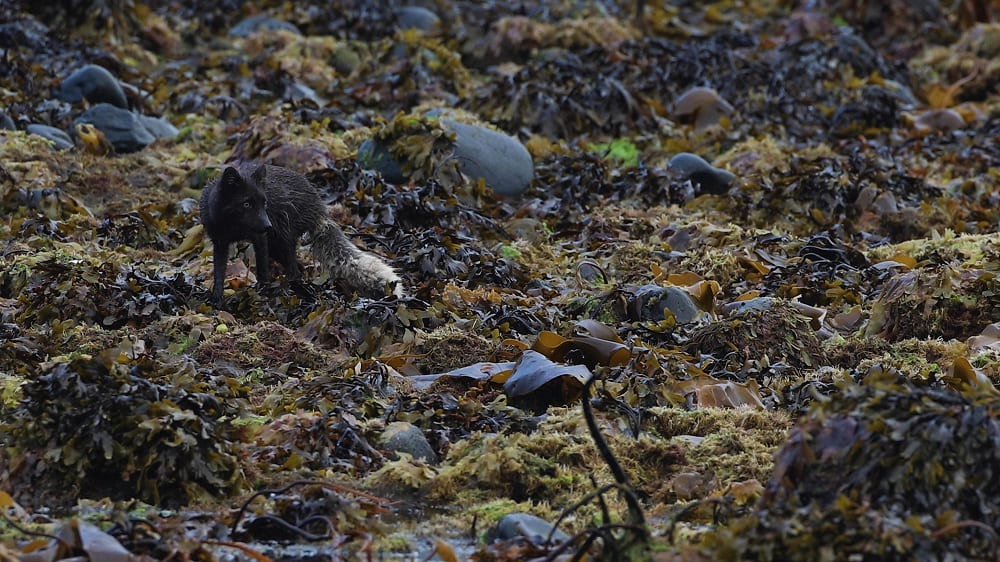
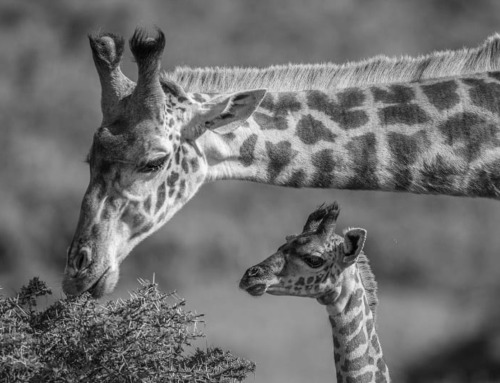
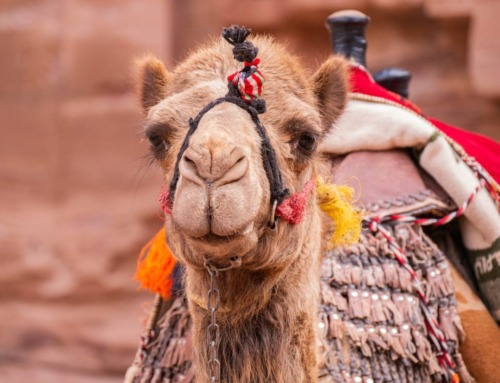
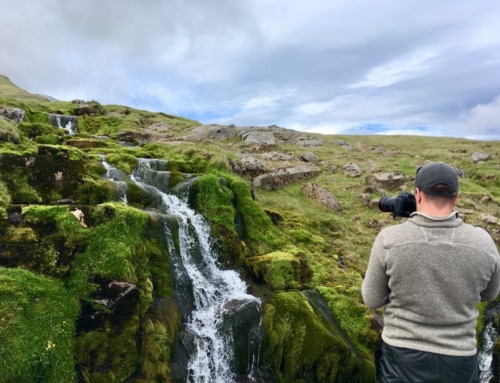
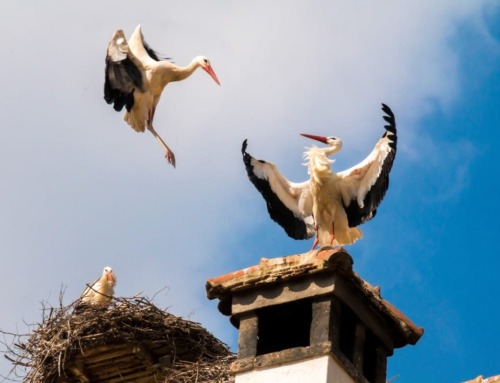
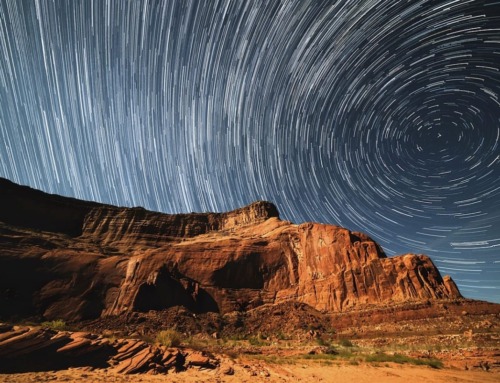

What an adventure to get to see arctic foxes in their natural habitat! I’ve been to Iceland once and we wanted to see some more wild terrain but it’s hard without having a valid drivers license to rent a car
Hi Alaine! That’s a good point, renting a car does often require a valid driver’s license. Logistically, it can be challenging to get up to Hornstrandir. Thankfully other incredible parts of Iceland are more easily discoverable :)
Oh, how interesting! I didn’t even knew they exist there!
Hey Valentina! Yes, they are the only native mammal in Iceland! They’re pretty elusive and difficult to see, so many people don’t get the chance to spot them. Hornstrandir is definitely the best place to do so!
They are absolutely beautiful! You must have been delighted.
Aren’t they great?? We were really thrilled to see them :) Definitely made waiting in the cold, rainy weather worth it!!